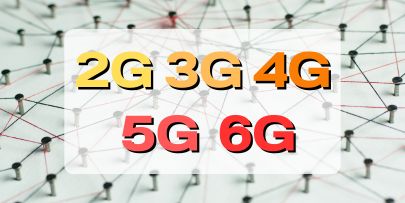The Coverage of the different Mobile Networks.
Coverage of different mobile networks is essential when setting up your Mobile Virtual Network Operator (MVNO). Coverage determines where your MVNO’s services are available, and it’s crucial for providing reliable service to your customers.
What is the Coverage of the different Mobile Networks?
- Why does the Coverage of the Mobile Network matter for Your MVNO?
- What is the Coverage of the different Mobile Networks?
- What is the Coverage of the 2G (Second Generation) Mobile Network?
- What is the Coverage of the 3G (Third Generation) Mobile Network?
- What is the Coverage of the 4G (Fourth Generation) Mobile Network?
- What is the Coverage of the 5G (Fifth Generation) Mobile Network?
- What is the Coverage of the 6G (sixth Generation) Mobile Network?
- Summary of is the Coverage of Mobile Networks
Why does the Coverage of the Mobile Network matter for Your MVNO?
Customer Experience
Reliable coverage ensures a positive user experience. Customers in areas with weak signals may switch to competitors if the service quality is poor.
Market Reach
Understanding coverage helps you identify your target market. Consider the demographics and geographical locations of your potential customers when selecting network technologies.
Service Offerings
Coverage influences the services you can offer. If your MVNO operates in areas with comprehensive 4G or 5G coverage, you can provide high-speed data services, attracting tech-savvy customers.
Roaming Agreements
Consider roaming agreements with operators offering compatible coverage. Roaming agreements expand your service reach globally.
Cost Considerations
Building your MVNO on networks with extensive coverage might be costlier. Balance cost and coverage to optimize your business model.
Future Expansion
If you plan to expand your MVNO’s services to new regions, understanding the coverage landscape is essential for strategic growth.
What is the Coverage of the different Mobile Network?
Here’s a detailed breakdown of the coverage for 2G, 3G, 4G, 5G, and a brief mention of the future generation (often referred to as 6G) networks, and why it’s important for your MVNO:
1. What is the Coverage of the 2G (Second Generation) Mobile Network?
2. What is the Coverage of the 3G (Third Generation) Mobile Network?
3. What is the Coverage of the 4G (Fourth Generation) Mobile Network?
4. What is the Coverage of the 5G (Fifth Generation) Mobile Network?
5. What is the Coverage of the 6G (sixth Generation) Mobile Network?

What is the Coverage of the 2G (Second Generation) Mobile Network?

Coverage
2G networks offer extensive coverage, reaching rural and remote areas. They operate in the 900 MHz and 1800 MHz frequency bands, allowing signals to travel over long distances and penetrate buildings effectively.
Significance for Your MVNO
2G networks are suitable for basic voice calls and text messaging. They provide reliable coverage even in areas with limited internet connectivity needs. Consider 2G coverage if your target market includes regions with basic communication needs and limited data requirements.
What is the Coverage of the 3G (Third Generation) Mobile Network?

Coverage
3G networks offer broader coverage than 2G, especially in urban and suburban areas. They operate in various frequency bands, such as 850MHz, 900MHz, 1900MHz, and 2100MHz.
Significance for Your MVNO
3G networks provide improved data speeds and are suitable for internet browsing and basic multimedia applications. While coverage is widespread in populated regions, it might be limited to extremely remote or mountainous areas.
What is the Coverage of the 4G (Fourth Generation) Mobile Network?

Coverage
4G networks provide robust coverage in urban, suburban, and some rural regions. They operate in frequency bands such as 700MHz, 850MHz, 1800MHz, 2100MHz, and 2600MHz.
Significance for Your MVNO
4G networks offer high-speed internet suitable for streaming, online gaming, and various data-intensive applications. While coverage is comprehensive in urban areas, occasional gaps might occur in densely populated or indoor locations.
What is the Coverage of the 5G (Fifth Generation) Mobile Network?

Coverage
5G networks are being deployed in urban areas, offering ultra-fast internet. They operate in frequency bands like 600MHz, 700MHz, 3.5GHz, 24GHz, and 28GHz.
Significance for Your MVNO
5G networks provide significantly higher speeds and lower latency compared to 4G. Initial deployments focus on metropolitan areas, providing high-speed, low-latency services. However, coverage might be limited to rural and remote areas initially.
What is the Coverage of the 6G (Sixth Generation) Mobile Network?

Expected Coverage
6G aims for ubiquitous global coverage, including remote and challenging environments.
Significance for Your MVNO
While 6G technology is in the early stages of research, the goal is to achieve seamless connectivity worldwide, even in challenging terrains. Researchers aim to overcome obstacles related to high-frequency signal propagation, ensuring connectivity in urban, rural, and underserved areas globally.
Summary of the Coverage of Mobile Networks
In summary, coverage plays a pivotal role in your MVNO’s success. It impacts on your market reach, customer satisfaction, service offerings, roaming capabilities, cost structure, and potential for future expansion. Choosing the right balance between coverage, technology, and cost is key to building a competitive and successful MVNO.







